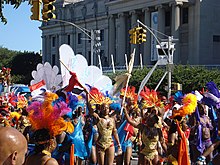Caribbean immigration to New York City
This article needs additional citations for verification. (May 2010) |
| Part of a series on |
| Race and ethnicity in New York City |
|---|
Caribbean immigration to New York City has been prevalent since the late 19th and the early 20th centuries.[1] This immigration wave has seen large numbers of people from Jamaica, Haiti, Cuba, Dominican Republic, Antigua and Barbuda, Guyana, and Trinidad and Tobago, among others, come to New York City in the 20th and 21st centuries. (There has also been significant migration from Puerto Rico, but this is not considered immigration as Puerto Ricans hold United States citizenship.) Caribbeans are concentrated in the Bronx, from 211th Street to 241st Street and Gun Hill Road. There are also Caribbean communities in Brooklyn, especially in the neighborhoods of Flatbush and Prospect Heights.[2]
History

In 1613,
In the early 1900s, the largest number of black immigrants were English-speaking
New York City also witnessed the institution building of Caribbean blacks. Majority of Caribbeans were
Hispanic
New York City has large populations of Caribbean including Puerto Ricans, Dominicans, and with smaller numbers of Panamanians, Cubans, Hondurans, and Costa Ricans.
Dominicans
Immigration records of Dominicans in the United States date from the late 19th century and New York City has had a Dominican community since the 1970s. From the 1960s onward, after the fall of the Rafael Trujillo military regime, large waves of migration have thoroughly transnationalized the Dominican Republic, metaphorically blurring its frontier with the United States.
In 2006 New York City's Dominican population decreased for the first time since the 1980s, dropping by 1.3% from 609,885 in 2006 to 602,093 in 2007. They are the city's fifth-largest national group (behind Irish, Italian, German and Puerto Rican) and, in 2009, it was estimated that they compromised 24.9% of New York City's Latino population.[6]
Areas with high a concentration of Dominicans are in Washington Heights, Corona, and certain areas in the Bronx. Eastern portions of the Washington Heights neighborhood and many western neighborhoods in the Bronx have some of the highest concentrations of Dominicans in the country.
Puerto Ricans
Puerto Ricans are Americans citizens by birth, so they are not immigrants.

New York City has the largest Puerto Rican population outside of Puerto Rico.
Puerto Ricans have historically lived in neighborhoods such as the
Cubans
New York City has the third largest Cuban population.[9]
References
- ^ Maddox, Dr. Tyesha. "NEW YORK: A CARIBBEAN CAPITAL". littlecaribbean.nyc. Retrieved May 29, 2019.
- ^ "West Indian New York Today".
- ^ "New York City begins to celebrate first immigrant -- a Dominican". archive.ph. Archived from the original on June 24, 2013. Retrieved November 28, 2022.
- ^ West Indian Migration to New York
- ^ Reimers, David. Other Immigrants: The Global Origins of the American People. New York, NY: New York University Press, 2005. 77–82. Print.
- ^ Bergad, Laird W (April 2011). The Latino Population of New York City 2009 (PDF). Latino Data Project. Center for Latin American, Caribbean & Latino Studies. Retrieved February 10, 2013.
- ^ a b Younge, Gary (November 10, 2006). "Flight to the death". The Guardian. Archived from the original on November 13, 2012. Retrieved October 15, 2013.
- Salon. Archived from the originalon November 28, 2011. Retrieved October 15, 2013.
- ^ "Cubans in the New York Metro Area" (PDF). unreachednewyork.com. November 2012.
Further reading
- Schmidt, Bettina E. Caribbean Diaspora in the USA: Diversity of Caribbean Religion in New York City. Ashgate, 2008. ISBN 978-0754663652.
- Foner, Nancy (August 15, 2001). Islands in the City: West Indian Migration to New York. University of California Press. ISBN 9780520228504.
